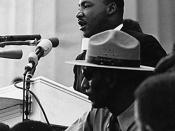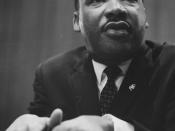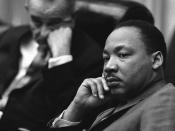Throughout history there have been many great public speakers and speeches. I have chosen to analyse Martin Luther King Junior's "I have a dream" speech, Mark Anthony's eulogy for Julius Caesar from the play "Julius Caesar" by William Shakespeare and Sir Winston Churchill's "On the beaches" speech, given in the House of Commons on June 4, 1940. I will be analysing the techniques employed by these three men to convey their messages in these three speeches.
Martin Luther King Jr. delivered his "I have a dream" speech on the steps of the Lincoln Memorial in Washington D.C. on 28 August, 1963. Martin Luther King was known as one of the best users of metaphors of all time and he demonstrated that ability throughout the speech.
Martin Luther King used metaphor to dramatically increase the power of his speech. In describing the treatment of Negroes, he said, "The life of the Negro is still sadly crippled by the manacles of segregation and the chains of discrimination."
He later said, "Now is time to rise from the dark and desolate valley of segregation to the sunlit path of racial justice. These metaphors really paint strong visual images for the audience of how Negroes were treated and where they should be heading.
Repetition was a technique that was used constantly in this speech. It was used as a way of building an atmosphere and getting the crowd involved in the speech. The most moving use of repetition occurred about two thirds of the way through the speech where he used "I have a dream" to start each sentence. In this section the main message of the speech is reinforced through repetition. That message is that all men are created equal and his dream is to see that message realised. By starting each...


